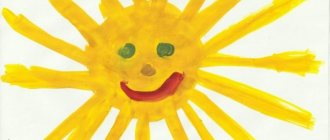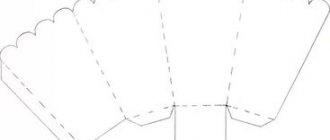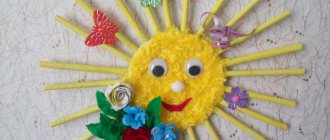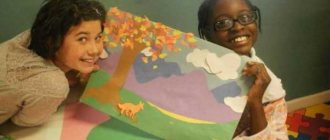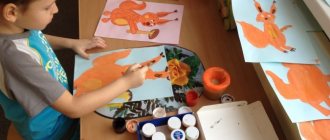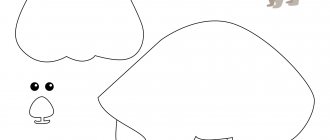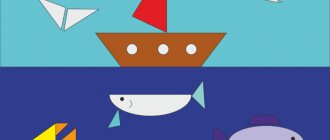MAGAZINE Preschooler.RF
Summary of educational activities with the participation of parents in the middle group. Designing paper “Sandals”Purpose: to teach paper design.
Tasks:
- Learn to fold a rectangular sheet of paper in half, aligning the sides and corners. Strengthen the ability to cut a rectangle into two long strips along the fold line. Reinforce safety rules when working with scissors.
- Develop coordination in the work of eyes and hands.
- Cultivate neatness.
- Activate subject and verb dictionary on the topic “Shoes” . Develop fine motor skills of the fingers. Develop attention and memory.
Equipment: box - postal parcel, paper sandals - sample, scissors, glue, napkins according to the number of children and adults, cardboard (rectangle with a drawn outline of the shoe footprint 16.5 cm x 8 cm - sole) and colored paper (strip 15 cm x 4 cm and a strip 30 cm x 2 cm - straps for sandals) according to the number of children and adults (the color of the cardboard matches the color of colored paper), decorations for straps made of colored paper (circles, hearts, etc.)
GCD move:
- Parents sit on chairs next to the carpet, children and the teacher sit on the carpet. The teacher shows the parcel.
- - Children, guess who this package is from (the teacher reads the riddle glued to the box).
They put dexterous two hands. Heels for shoes, And heels for heels - Also the work of these hands.
(shoemaker)
-What does a shoemaker do?
The teacher looks into the package
— Children, the parcels contain shoes, what kind of shoes do you know?
The teacher takes sandals from the package.
— What is the name of these shoes, why?
The teacher reads a letter from the shoemaker. “Please help me complete a large order for sandals. I am sending you the details: soles and straps. They need to be prepared and glued. Thank you in advance. Shoemaker"
3. The teacher takes cardboard rectangles from the parcel.
Game "Find a pair" .
Children are given one rectangle (with a trace outline). The rest are laid out on the table. Children need to choose a matching left or right pair of shoes.
4. The teacher takes strips of colored paper from the parcel and places them on the table.
Game “Match by color”
Children need to choose matching color straps (wide and narrow stripes) for their soles.
5. Physical exercise “Here is the right one, here is the left one” (song with words and music by Ekaterina and Sergei Zheleznov). The teacher, parents and children perform actions in accordance with the text of the song.
6. Adults and children sit down at the tables. The teacher shows how to make sandals from parts and explains who will do what.
Parents cut out the sole from cardboard along the contour.
Children: - fold a wide strip in half (long side to long side), iron the fold, unfold and cut the strip into two parts along the fold line.
— fold a narrow strip in half (short side to short side), iron the fold, unfold and cut the strip into two parts along the fold line.
Parents and children together glue decorations onto narrow strips, then glue straps to the sole (a narrow strip on the toe, and a wide strip at an angle on the heel).
7. The teacher talks with the children about the rules of working with scissors.
— Do not hold the scissors with the ends up.
— Do not leave scissors open.
— When working, watch the fingers of your left hand.
— Place the scissors on the table so that they do not hang over the edge of the table.
— Pass the closed scissors in rings towards a friend.
- Do not cut with scissors while walking, do not approach your friend while cutting.
8. The teacher conducts finger gymnastics with children and parents.
Five fingers on your hand Call by name sumey. The first finger is the lateral one - called the thumb. The second finger is a diligent pointer, it is not for nothing that they call it the index finger. Your third finger is right in the middle. Therefore, the middle one is given a name. The fourth finger is called the ring finger, it is clumsy and stubborn. Just like in the family, Brother Junior is the favorite. He is the fifth in a row, called the little finger.
9. Children and parents begin making sandals.
10. Summary. Exhibition of sandals.
Bibliography:
Preschool speech center. Handouts for working with children 5-7 years old. Appendix to the book “Preschool speech point. Documentation, planning and organization of work"
| Next > |
Progress of the lesson to study the topic “Utensils”
1. Lesson “Magic bag”
“I have this beautiful bag, and there’s something in it.” Let's see what's inside? Children take turns taking objects out of the bag. Children (3-4 years old) - one object at a time, name it and put it on the table. The older ones try to guess the object by touch, take it out and put it on the table.
2. Conversation
— How can you call all these objects in one word? - Why do we need it? For children (3-4 years old) they name a specific item and ask what we need it for.
3. Lesson “Feed Masha”
— The doll Masha came to visit us. And as is customary, guests must be treated to something. — Let's prepare lunch for our guest. What do we need for this? (Pot, ladle, frying pan) The utensils that we need for cooking are called kitchen utensils. - Let's feed Masha our lunch. What will we take for this? (Deep plate, shallow plate, fork, spoon) The dishes from which we eat are called tableware, and what we use is called cutlery. - Well, after lunch you can give Masha some delicious tea. Take the dishes that we need for this (teapot, saucer, cup, teaspoon). It's called a tea room.
4. Physical school
5. Lesson “What is it stored in?”
Illustrations are posted on the board. Children (5-7 years old) say the answer themselves. An adult helps the younger ones. — Sugar (in a sugar bowl) — Salt — Pepper — Butter — Bread — Sweets — Sauce — Tureen
6. Lesson “What dishes are made of”
An adult places plates (salad bowls) on the table. - How are all these objects similar? (form, purpose) - How are they different? (color, material of manufacture) - Dishes are made from different materials.
Tell me the name of the dishes made from: Glass Wood Porcelain Plastic Metal (Older children name it themselves, younger children with the help of an adult) - If you drop a glass plate, what will happen to it? — If you drop a spoon on the floor, what happens to it?
7. Activity “Collect the fragments”
Children are given pictures of objects cut into several parts. We need to collect pictures. “I wasn’t careful today and broke several objects.” Collect the pictures and find out what was broken.
8. K. Chukovsky “Fedorino’s grief”
- Let’s remember the fairy tale “Fedorino’s grief.” - What happened to Fedora? - Why did the dishes run away from her? — How should you care for plates, forks, and spoons?
9. Summary of the lesson
— Today we talked about dishes, that they are very important and necessary in our lives. We found out that it can be a tea room, a kitchen room, or a dining room. It is made from various materials, so it can be glass, porcelain, wood, or metal. Some materials make it strong, while others make it fragile and can be broken. The dishes must be handled very carefully, washed and put back in their places.
“Rocket” – GCD for paper construction
Smirnova Irina Grigorievna Tregubova Larisa Viktorovna Grebenikova Tatyana Alekseevna educators MBDOU "Kindergarten of the village of Tomarovka of the Yakovlevsky urban district"
The material was sent for publication in the All-Russian printed collection of practice-oriented materials “Preschool and primary education - modern methods and technologies of teaching and upbringing” - July-August 2021.
ROCKET NOD in the senior group - paper construction
Goal: to expand children's understanding of space. To develop the ability to create a three-dimensional design of paper rockets using a diagram and a sample.
Advertising message
Tasks:
- Educational: consolidate the names of geometric shapes: circle, rectangle, triangle; construction parts: cone, cylinder, cube. Teach children how to twist a rectangle into a cylinder, a circle into a cone.
- Developmental: develop design skills, the ability to convey the expressiveness of a composition, using the features of paper as a design material. Develop spatial thinking, imagination, and the ability to make inferences. Form a critical attitude towards your actions, objectively evaluate your work and the work of your comrades.
- Educational: to cultivate interest in paper construction. To cultivate accuracy in working with glue and scissors, independence, and initiative. Cultivate a desire to help a friend.
Integration of educational areas : Speech development, cognitive development, artistic and aesthetic development.
Enrichment and activation of the dictionary: Space, cosmodrome, planets, astronaut, orbit, body, nozzles, porthole, design bureau.
Methods and techniques: game problem situation, riddle, conversation - dialogue, looking at illustrations, outdoor play, verbal play, productive activity of children, self-analysis of work, summing up - reflection.
Equipment: a letter asking for help, illustrations depicting rockets, a sample of a finished rocket, parts of a three-dimensional construction set, an audio recording of space music.
Handouts: rocket design diagrams, cardboard, colored paper, scissors, glue, napkins, oilcloth.
Progress of continuous educational activities:
Cheerful music plays and children join the group.
Educator: Guys, today we have guests, let's say hello and invite them to come.
Children: hello!
Educator:
We will all stand in a circle together, You are my friend and I am your friend, Let’s hold hands tightly and smile at each other.
The teacher makes a riddle about space.
Educator: Guys, it’s not in vain that we started talking about space! Today our group received a letter asking for help. Shall we read it? (Yes!)
Educator: Dear guys! Soon there will be an epidemic on the planet “Zhelezyaka”! All the rockets and aircraft here have broken down, and the robots cannot make their flights. Help!
Guys, let's help the robots from the planet "Zhelezyaka"? How can we help robots?
Children's answers: Make rockets and launch them into space onto the planet.
Educator: Can you?
Children: Yes!
Educator: Who creates rockets? (designers, engineers)
Educator: today I suggest you be designers and design rockets for the inhabitants of the planet “Zhelezyaka”. I, as the chief designer, propose to consider rockets (there are illustrations of rockets on the easel)
Next, children examine a sample of a finished rocket made of colored paper and cardboard.
Educator: What parts is the rocket made of?
Children's answers: The nose of the rocket is made of a cone, the main part - the body - is made of a cylinder, the nozzles are made of triangles, the windows are made of circles.
Educator: but before you start creating rockets, do you want to play? (Yes!)
Outdoor game “Lay out the details of the construction set”
Children are divided into two teams and come up with a cosmic name for their team. Countdown: 3, 2, 1 – Start!
After the game, the teacher says that creating a rocket is a difficult and responsible job. You can pair up, agree on who will do what, and help each other.
Educator: please go to the design bureau!
Repetition of the rules for working with scissors and glue.
- Scissors must not be left open.
- You should not bring scissors close to your face.
- Pass the scissors to each other with the rings first, not the tip.
- Handle the glue carefully.
Look how many dangerous objects are lying around! If you do not follow safety precautions, you can injure yourself or a neighbor!
Educator: Guys, we have a problem! As you already said, to design a rocket you need a cone and a cylinder, we don’t have them.
But there is a design scheme. She will help us.
Look at it carefully and tell me, from what geometric figure can you get a large cylinder?
Children's answers: from a large rectangle, twisting it into a cylinder - a rocket body; from the circle, twisting it - the nose part. We attach the airlocks - triangles, and the portholes - circles to the body.
Educator: It's time to get to work (on the tables there is a set of geometric shapes for each child - a large rectangle, a circle, two triangles, small circles for portholes). During the activity, the teacher provides individual assistance.
Children place finished rockets in one line at the Mechta cosmodrome
Presentation of finished works
Educator: What beautiful rockets you have made, but can all rockets fly to the planet “Zhelezyaka”?
I'll give you one gold star. This is your voice. You will give it away - vote for your favorite work - (put a star next to the rocket).
Which rocket gets the most stars will be considered the best. (This is how children perform visual analysis of work)
Educator: Well done designers! Everyone did it! Will the inhabitants of the planet “Zhelezyaka” like your rockets? (Yes!). Applause!
Educator: Guys, I’m wondering
- -What are people called who fly into space on spaceships? (astronauts)
- -What was the name of the world's first astronaut? (Yuri Gagarin)
- -What was the name of the ship that lifted him into the sky? ("East")
Guys, do any of you want to become an astronaut?
To become an astronaut, what qualities do you need to have? (to be strong, courageous, resilient, responsible)
Educator: You are right, but astronauts must also follow the rules.
Word game "Space rules"
- If you want to become an astronaut, you must know a lot, a lot...!
- Any space route is open to those who love... work.
- Only friendly starships can take with them…on a flight.
- We will not take the boring, gloomy and angry into… orbits.
- Our main rule is to carry out any... order
- Fast rockets are waiting for us to fly to... planets.
- Whichever one we want, that’s the one… we’ll fly.
Let's train like astronauts and fly. I think that now the robots from the planet “Zhelezyaka” will invite us to visit.
Reflection: Guys, what did we do today? Who did they help? What games did you play? Was it difficult for you? What was the most difficult thing? What did you like most? Children's answers.
Literature:
- Kutsakova L.V. Construction and manual labor in kindergarten: Program and lesson notes M: TC Sfera, 2021. – 341 p.
You can see the table of authors and learn more about the collections HERE
Construction using the origami technique “Fox” for the middle group
Goal: Continue to introduce children to the origami technique. Introduction to basic forms.
Tasks:
Educational: increase interest in origami through play, learn to fold a square in different directions, create compositions with paper products, consolidate technical skills in working with paper.
Developmental: develop attention, memory, fine motor skills and eye.
Educational: to cultivate interest in paper design, to cultivate independence.
Demonstration material: illustrations of a fox, finished craft, finished basic form, orange paper.
Handouts: orange paper for origami, scissors, black pencil for eyes and nose.
Repetition of the rule for working with scissors:
1. Store scissors in a specific place
2. Place the scissors with the sharp ends closed away from you
3. Pass the scissors to each other, rings first
Preliminary work:
Looking at pictures, illustrations, reading stories, fairy tales, poems and guessing riddles on the topic
Organizing time:
The teacher offers to look at a picture of a fox and asks them to tell who is depicted in the picture and what they know about the fox.
Conversation with children.
Educator: The fox is a beautiful animal. Her body is covered with thick red fur. The fox has a luxurious fluffy tail. She has short legs and a sharp muzzle. The fox's eyes are beady and glow with a cunning fire.
Foxes live all over the globe. They live not only in forests, but also in the tundra and steppes.
- Who can tell me, guys, what do foxes eat? - That's right, foxes eat hares, mice, birds, fish, and also like to eat berries, fruits, and vegetables.
Foxes are very careful. In case of danger, they confuse their tracks and hide them in other places. Because of this, the fox is called the most cunning animal.
Foxes live as a small family in a hole they dig in the forest. They have keen eyesight and sense of smell.
Foxes are considered useful animals; they eat small rodents.
Many fairy tales and stories have been invented about the red-haired beauty. What is another name for a fox? (Children’s answers.) That’s right, the guys call the fox “red-haired cheat”, “fox-sister”, “Fox-Patrikeevna”.
- And now, guys, I suggest making everyone their own paper fox, don’t you agree?
First we need to stretch our fingers.
Finger gymnastics:
Let's go for a walk (hands clenched into fists, thumbs running across the table)
And the second ones catch up (index fingers “run” across the table)
Third fingers run (“middle fingers run”)
And the fourth ones walk (“ring fingers walk”)
The fifth finger jumped (touch the table rhythmically with both little fingers)
And at the end of the path he fell (slam his fists on the table).
Practical part:
Creating a fox using origami technique.
1.Fold the paper and cut out a square
2. Take the opposite corners and fold our square in half
3. Bend the end of the triangle to the opposite middle
sides.
4. We bend the left and right side ends upward to create ears.
(The teacher shows the sequence of techniques for folding a figure, draws attention to accuracy in working with paper. If necessary, provides individual assistance.)
- So we have the face of a fox. What is our little fox missing? (Children's answers.) - That's right, of course the nose and eyes are missing. To do this, we will draw them with a black pencil.
But before that, let's have a physical moment with you. (Children get up for physical exercise.)
Physical education minute:
Three nods.
Four - arms wider,
Five - wave your arms.
Six - sit down quietly.
- Guys, now let’s draw our fox’s nose, eyes, and now our little fox is ready.
Lesson summary:
- Guys, what did we do today?
What did you get out of our lesson?
What other animals would you like to learn how to make from paper?
These are our little foxes!

